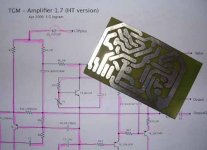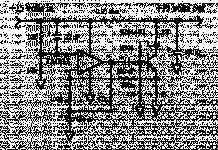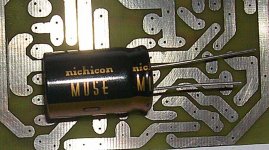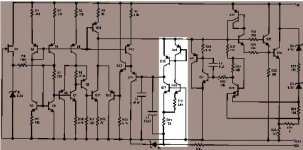Lumba Ogir said:Wavebourn,
may do, it has however a more favourable noise, turn-on and impedance characteristic but also some repugnant features like massive feedback and intricate circuit topology, depending on brand. Some IC regulators use 1.2V reference, which is preferable from a functional point of view.
Wrong again.
TL431 uses a bandgap reference which is whatever you want but not a zener. And the topology has nothing to do with the brand, all are clones of the original LM431 topology.
And again, you are presenting your own idiosyncrasies ("repugnant features like massive feedback and intricate circuit topology") as truth.
1.2V reference, that's in no way different to what TL431 is using - the same bandgap reference.
Lumba Ogir said:syn08,
as usual, I`m having tremendous difficulty agreeing.
As usual, I totally agree with you here. We belong to two completely different breeds.
My secret wish about the GEB members is them to let technical details like these to those qualified to talk about. However, they can rant about the poor sound of TL431 until the cows come home, I'm not going to debate that. If they would like to know what are the weak points of LM431, and a fair comparison to other voltage references, all they have to do is to ask and then listen
Unfortunately, it's not going to happen.
EDIT: Let everybody know when you are finishing building any kind of decent performance voltage/current regulator without "massive amounts of feedback". That moment is going to be a breakthrough in electronics design.
AKSA said:Ovidiu,
That was very personal and elitist. What do you hope to achieve by promoting the technocrats as high priests, when this is merely a DIY site, not a peer forum for highly qualified engineers?
DIY or not, wrong is wrong is wrong. I don't mind errors (I'm doing myself enough such), I don't mind subjective opinions, but wrapping some personal idiosincrasy with a layer of conveniently supporting techo-babble or flat wrong information is more than I can take.
EDIT: Don't worry, the amount of BS floating around is the main reason why so many "highly qualified engineers" left or almost left this place. I'm myself starting to get tired, I still find it mildly entertaining but, at the current rate and trend, this place will soon become a mixture of self appointed experts, snake oil merchands and innocent amateurs.
Member
Joined 2009
Paid Member
Here's the 2nd pcb for playing with the amp. I don't know why, but making pcb's drives me crazy. Seems that as soon as I work out a method than it stops working. My wife is starting to suspect that I know how to use the iron afterall 
p.s. a bit of active debate on the thread is fun, don't let it get too 'active'.
p.s. a bit of active debate on the thread is fun, don't let it get too 'active'.

Attachments
Member
Joined 2009
Paid Member
My original question was about choosing a low noise regulator. I expect that there are people who have avoided the 3-terminal type in favour of the low noise variety now available. I don't know if these low noise regulators can be further improved on with discrete circuits or with additional circuitry.
Here's a link that peaked my interest on the latter option: http://www.wenzel.com/documents/finesse.html
Here's a link that peaked my interest on the latter option: http://www.wenzel.com/documents/finesse.html
Attachments
Bigun said:My original question was about choosing a low noise regulator. I expect that there are people who have avoided the 3-terminal type in favour of the low noise variety now available. I don't know if these low noise regulators can be further improved on with discrete circuits or with additional circuitry.
Here's a link that peaked my interest on the latter option: http://www.wenzel.com/documents/finesse.html
That noise cancelling circuit works very well. However, depending on your requirements, you could get along with a much simpler implementation.
Sorry for not really following this thread, what is this regulator for?
Gareth,
You have options. You could use:
1. Simple emitter follower with resistive divider/cap on the base,
2. Conventional current source,
3. 'Clean up shunt' device as in the website you linked, or
4. Three terminal regulator.
I would use 1, as the regulation is not too important, but rather the hoise is the critical issue.
Variations in stage current do not have as much influence on sound quality as is imagined; LTSpice reveals little difference in distortion profile for up to about 10% unbalance. But noise does.
Hugh
You have options. You could use:
1. Simple emitter follower with resistive divider/cap on the base,
2. Conventional current source,
3. 'Clean up shunt' device as in the website you linked, or
4. Three terminal regulator.
I would use 1, as the regulation is not too important, but rather the hoise is the critical issue.
Variations in stage current do not have as much influence on sound quality as is imagined; LTSpice reveals little difference in distortion profile for up to about 10% unbalance. But noise does.
Hugh
Member
Joined 2009
Paid Member
syn08 said:Sorry for not really following this thread, what is this regulator for?
supply for the input stages of the amplifier. The output stages will take their power from a separate supply (unregulated). For the reasons you'll have to go back through the thread ...
Member
Joined 2009
Paid Member
syn08,
the feedback effects is one influential reason for the poor sonic performance of IC voltage regulators. Just looking at the circuit diagram can deter some of us from letting the audio signal travel through such a muddle.
You may have partially misunderstood me concerning IC voltage references.
Since sound quality cannot be truthfully expressed in figures and graphs, there will never be a consensus on these matters. Calm yourself down and accept it with humility.
the feedback effects is one influential reason for the poor sonic performance of IC voltage regulators. Just looking at the circuit diagram can deter some of us from letting the audio signal travel through such a muddle.
You may have partially misunderstood me concerning IC voltage references.
Since sound quality cannot be truthfully expressed in figures and graphs, there will never be a consensus on these matters. Calm yourself down and accept it with humility.
Lumba Ogir said:the feedback effects is one influential reason for the poor sonic performance of IC voltage regulators. Just looking at the circuit diagram can deter some of us from letting the audio signal travel through such a muddle.
Since sound quality cannot be truthfully expressed in figures and graphs, there will never be a consensus on these matters.
:bs: as usual. Do you need me to put this in figures and graphs, or would you take my word for it?
I'm not expecting a consensus, I'm just expressing with humility my opinion. Based on facts, not on myths and legends, seasoned with snake oil.
Member
Joined 2009
Paid Member
I believe that measurements count for something.
The data sheet for the low noise regulator I mentioned talks of 40uV max noise over a wide bandwidth. I thought 40uV was good.
Then I found measurements of a simple zener EF regulator here: http://www.tnt-audio.com/clinica/regulators_noise3_e.html
and here the measured noise is very much less than the 'low noise' regulator. Hmmmm.
The data sheet for the low noise regulator I mentioned talks of 40uV max noise over a wide bandwidth. I thought 40uV was good.
Then I found measurements of a simple zener EF regulator here: http://www.tnt-audio.com/clinica/regulators_noise3_e.html
and here the measured noise is very much less than the 'low noise' regulator. Hmmmm.
post 167
finesse regulators were scrutinised here:
http://www.pstca.com/spice/ripple/ripple.htm
option 2 and 3 look worthwhile.
finesse regulators were scrutinised here:
http://www.pstca.com/spice/ripple/ripple.htm
option 2 and 3 look worthwhile.
Gareth,
LM 317 circuit diagram with the BGR highlighted. It is not a very attractive design for audio use, small operating frequency range (yet still wider than that of fixed-voltage regulators) and the noise level just cannot be low, however it`s a much better choice than an unregulated supply.
They certainly do - for something.I believe that measurements count for something.
LM 317 circuit diagram with the BGR highlighted. It is not a very attractive design for audio use, small operating frequency range (yet still wider than that of fixed-voltage regulators) and the noise level just cannot be low, however it`s a much better choice than an unregulated supply.
Attachments
Member
Joined 2009
Paid Member
who needs a regulator...
Lumba / All - I've become convinced that 'regular' regulators are indeed noisy enough to be a poor choice for the application I'm talking of.
The use of a regulator is part of the dual supply approach. With the dual power supplies one of the benefits is the separation of the front end of the amp from the output stages. A clean supply for the front and no longer needing the RC filters on the supply rails between the output stage and the front end of the amplifier.
But the TGM (and AKSA) uses a bootstrap feedback to the linearize the VAS. If you separate off the front end of the amplifier you still end up with the output signal modulating the +ve supply rail. This isn't an issue if you keep the RC filter in place on the LTP supply. I tried removing the filter in Spice and of course you get gobs of H2 distortion and the potential to inject cross talk to other channels depending on how well the regulator can enforce it's control. But the bootstrap is designed to be used in conjunction with a diode in the front end +ve supply rail, which nicely adds to the mess.
The benefits of a regulated supply are therefore diminished. There's ways around this, but it pushes the TGM1 further away from the AKSA design, which is the role model for this version. Perhaps I should shelve the regulated psu option until I explore version 2 where the LTP has it's own 'regulator' built into the design.
==
on a different topic - I'm wondering if I can drop in a pair of JFETs into TGM version 1 without degeneration resistors ?
Lumba / All - I've become convinced that 'regular' regulators are indeed noisy enough to be a poor choice for the application I'm talking of.
The use of a regulator is part of the dual supply approach. With the dual power supplies one of the benefits is the separation of the front end of the amp from the output stages. A clean supply for the front and no longer needing the RC filters on the supply rails between the output stage and the front end of the amplifier.
But the TGM (and AKSA) uses a bootstrap feedback to the linearize the VAS. If you separate off the front end of the amplifier you still end up with the output signal modulating the +ve supply rail. This isn't an issue if you keep the RC filter in place on the LTP supply. I tried removing the filter in Spice and of course you get gobs of H2 distortion and the potential to inject cross talk to other channels depending on how well the regulator can enforce it's control. But the bootstrap is designed to be used in conjunction with a diode in the front end +ve supply rail, which nicely adds to the mess.
The benefits of a regulated supply are therefore diminished. There's ways around this, but it pushes the TGM1 further away from the AKSA design, which is the role model for this version. Perhaps I should shelve the regulated psu option until I explore version 2 where the LTP has it's own 'regulator' built into the design.
==
on a different topic - I'm wondering if I can drop in a pair of JFETs into TGM version 1 without degeneration resistors ?
Member
Joined 2009
Paid Member
Gareth,
I don`t agree with your reasoning. A clean power is always beneficial. The distortion products from the supply will modulate the audio signal. It does not sound nice.
Why are you against degeneration resistors?
Perhaps I will introduce him to you later on.Who's Andy ?
I don`t agree with your reasoning. A clean power is always beneficial. The distortion products from the supply will modulate the audio signal. It does not sound nice.
A high impedance CCS would linearize it more.But the TGM (and AKSA) uses a bootstrap feedback to the linearize the VAS
The various modulation effects from the output section would decrease substantially, resulting in lower distortion, noise and enhanced stability.If you separate off the front end of the amplifier you still end up with the output signal modulating the +ve supply rail.
I cannot see why would that happen.I tried removing the filter in Spice and of course you get gobs of H2 distortion
Why are you against degeneration resistors?
- Status
- This old topic is closed. If you want to reopen this topic, contact a moderator using the "Report Post" button.
- Home
- Amplifiers
- Solid State
- TGM Amplifier ?



